|
In the 1930s the South African financier and statesman Sir Abe Bailey (1864–1940), together with several other prominent Rhodesians, was responsible for the inauguration of a Rhodes Memorial Foundation Fund: its purpose being to establish a Rhodes Memorial Museum in Bishop’s Stortford.
An overwhelming response to the fund enabled them to buy Netteswell House where Cecil Rhodes was born, as well as the adjoining house, Thorley Bourne, where the family later lived until 1874. Both houses were then furnished with many pieces donated by the Rhodes family, and on completion the Foundation Trustees conveyed the freehold of the properties to the Urban District Council for them to administer.
It opened to the public on 11 July 1938 – Rhodesian Founders Day – the ceremony performed by the Marquess of Lothian in front of an invited audience that included the town’s Mayor, district councillors and several eminent Rhodesians and South Africans.
In 1952, Sir Ernest Oppenheim, Chairman of the Rhodesian Mining Corporation, instigated a scheme to completely remodel the museum and include an exhibition depicting the life of Cecil Rhodes and his activities in South Africa. Approval was given and on 5 July 1953 – the centenary year of Cecil Rhodes’s birth – the remodelled museum was opened by Sir Dougal Malcolm, President of the British South Africa Company that Rhodes had founded in 1889.
Two years prior to this, Doctor Gammie, one of the town’s medical practitioners and a prominent town councillor, had called a public meeting at which he asked for support to raise funds for ‘a much needed Public Hall’. To be known as the Rhodes Memorial Hall and built on the site adjoining Rhodes's birthplace, it was hoped the building could be started in 1953. But every effort made by the committee formed to raise money for the project resulted in very little return and by the end of 1951 there was barely £800 in the kitty. A further public meeting attracted few people and even less enthusiasm, and though the fund had swollen to £3,000 by 1954 the scheme was eventually abandoned.
By 1961 the museum was in a poor state of repair, attracting very few visitors. This prompted the Management Committee to generate a more universal interest in the site, which led to the proposal of a Commonwealth Centre that would be a focus for countries of the Commonwealth. It would act as an educational centre to promote unity and understanding amongst the various nations through knowledge of each other’s culture, traditions and varied ways of life, and would also serve as the much needed Public Hall for which the original fund had been intended.
On condition of a Public Appeal being launched both in the UK and abroad, the Rhodesian Mining Companies promised £20,000, as did Bishop’s Stortford Urban District Council. The Rhodes Committee managed to raise almost £5,000 and by 1962 there was enough capital to turn the plan into reality.
The original concept for the Memorial Hall in 1951 was for a building on two levels; the upper floor to accommodate a small cinema and meeting rooms and the lower floor to act as a theatre, with changing rooms, committee rooms, and facilities to serve refreshments. In reality this scheme was far too grand and responsibility for the design of a more practical building was given to 22 year-old John Smith from the Council Surveyors department. Completing the plans within a year, he provided for a large hall with seating for 470 people, changing rooms, kitchen and separate lounge area.
The foundation stone was laid on 28 February 1963 by Mr John Tilney MP Under Secretary of State at the Commonwealth Relations Office, and construction work started soon after in the former gardens of the two houses. Between 1851 and 1854, Rev Francis Rhodes had completely refurbished these gardens by planting a large variety of trees and shrubs, and though some of it still remains, as does part of the old perimeter wall, it was later turned into a car park for the Centre.
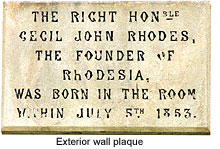 One unfortunate but amusing incident that occurred during building work involved the disappearance of a stone Roman coffin, found in 1962 near to Hockerill College. On removal from the site it was slightly damaged and later left in the garden of the Rhodes museum for safekeeping. Unfortunately, workmen mistook it for hardcore and used it to pack the foundations of the new Rhodes Centre.
One unfortunate but amusing incident that occurred during building work involved the disappearance of a stone Roman coffin, found in 1962 near to Hockerill College. On removal from the site it was slightly damaged and later left in the garden of the Rhodes museum for safekeeping. Unfortunately, workmen mistook it for hardcore and used it to pack the foundations of the new Rhodes Centre.
Nine months after building work began the Centre was complete, although the original £60,000 cost had by now escalated to £75,000. With £25,000 still required to pay off the financiers, organisers were confident this could be raised and a further £50,000 was soon donated – half coming from the people of Bishop’s Stortford, the remainder from companies in the UK and abroad.
The Rhodes Memorial Museum and Commonwealth Centre was officially opened on 5 December 1963 by the Duke of Devonshire, Minister of State for Commonwealth Relations, and was the first centre of its kind to open outside London. Two war memorial plaques in memory of the fallen of two world wars were also unveiled on that day by members of Bishop’s Stortford’s British Legion, each dedicated by Mr David Farmborough the vicar of St Michael's church and Chaplain to the Royal British Legion. Money from the original 1951 fund was used to create a war memorial within the entrance foyer.
|
|
Emblems of present and former Commonwealth countries were mounted on the outer wall of the entrance side, and at the rear of the building a large outline map of South Africa adorned the north wall. Other features inside that reflected links with Commonwealth countries, especially Africa, included a teak wood lounge floor presented by the Government of Rhodesia and furniture provided by the Government of India. A wooden seat in the garden was presented by the city of Salisbury (now Harare) when the original museum opened in 1938.
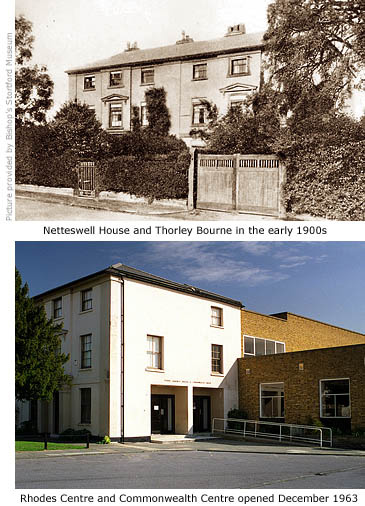 The committee wasted no time in getting the Centre up and running and musical events were quickly promoted. On 29 November 1963, a week before the official opening, the first event to be held was the Policemans Ball, attended by Bill Small and his orchestra and, of course, a number of policemen! The Grand Opening Dance took place the following evening. The committee wasted no time in getting the Centre up and running and musical events were quickly promoted. On 29 November 1963, a week before the official opening, the first event to be held was the Policemans Ball, attended by Bill Small and his orchestra and, of course, a number of policemen! The Grand Opening Dance took place the following evening.
Within months Rhodes Centre became a popular venue for visiting Pop groups, weekly dances, music clubs and even professional wrestling, but by the end of the decade the music revolution had abated and Rhodes Centre was left to find new ways of raising money. This included, plays, pantomimes, exhibitions, craft fairs and use by the local operatic society.
The Rhodes Centre was built for use by the people of Bishop’s Stortford, with entrance charges sufficient only to cover the cost of running the building. Any remaining monies were to be spent on maintenance of the museum and Centre. It was registered as a charity with trustees appointed to administer the Trust but, not surprisingly, there was very little money to play with and the trustees always had to work hand to mouth to keep it running.
As a consequence, the building eventually became run-down and in more recent years the town’s premier venue for social events began to lose its gloss. Local government restructuring in 1974 meant responsibility for the Trust was transferred to the Bishop’s Stortford Town Council, and a Management Committee was set up to run the Centre. A later alteration to the Trust Deed combined the functions of both the Management Committee and Trustees, their work being supported by a small annual grant from town and district councils. In 1995 local government funding was withdrawn altogether, threatening its closure as a museum and entertainment centre, but in 1997 both councils combined to replace the roof out of capital grants and have since helped out with Revenue Grants.
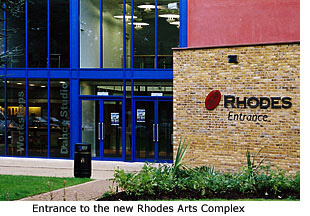 In 1999 a refurbishment project was started to make the Rhodes Centre a prime cultural venue and include a museum. Requiring funding to the tune of over £3 million, sponsorship by local companies and public fund raising accumulated over £750,000, and a £500,000 contribution was secured after a successful bid for funding to the Heritage Fund Lottery. A further bid to the Arts Fund Lottery was rejected but the Town Council agreed to contribute £240,000 and East Herts District Council approved a capital grant of £1.92 million towards the final cost of the work to be completed in 2005.
In 1999 a refurbishment project was started to make the Rhodes Centre a prime cultural venue and include a museum. Requiring funding to the tune of over £3 million, sponsorship by local companies and public fund raising accumulated over £750,000, and a £500,000 contribution was secured after a successful bid for funding to the Heritage Fund Lottery. A further bid to the Arts Fund Lottery was rejected but the Town Council agreed to contribute £240,000 and East Herts District Council approved a capital grant of £1.92 million towards the final cost of the work to be completed in 2005.
Before refurbishment began early in 2004, seventeen rooms in the two houses exhibited a fascinating museum recording the life of Cecil Rhodes and the history of South Africa. This included the room in which he was born in 1853, recreated as it was with four-poster bed and his original cradle. Also on display was a bust of Rhodes created in 1901 by Sydney March.
The new museum was officially opened on 11 November 2005. It includes many of these items but now focuses on the history of the Rhodes Victorian period and African art and culture. Also here is Bishop’s Stortford Local History Museum, previously housed at Cemetery Lodge, Apton Road. Taking up most of the second floor of this building, there is now ample space to display the countless items previously kept in storage. Included are displays from pre-historic times, the skeleton and stone coffin of a Romano-Briton discovered at Cannons Close in the 1950s, and a Gilbey Gallery showing the family’s influence on the town.
|


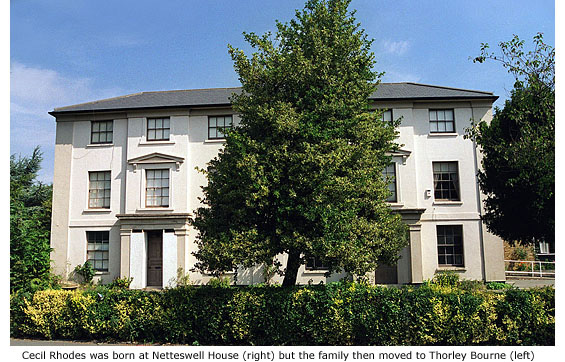
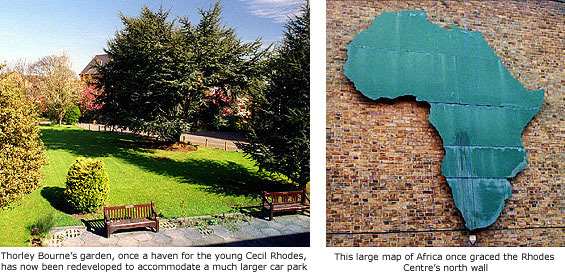

 One unfortunate but amusing incident that occurred during building work involved the disappearance of a stone Roman coffin, found in 1962 near to Hockerill College. On removal from the site it was slightly damaged and later left in the garden of the Rhodes museum for safekeeping. Unfortunately, workmen mistook it for hardcore and used it to pack the foundations of the new Rhodes Centre.
One unfortunate but amusing incident that occurred during building work involved the disappearance of a stone Roman coffin, found in 1962 near to Hockerill College. On removal from the site it was slightly damaged and later left in the garden of the Rhodes museum for safekeeping. Unfortunately, workmen mistook it for hardcore and used it to pack the foundations of the new Rhodes Centre. The committee wasted no time in getting the Centre up and running and musical events were quickly promoted. On 29 November 1963, a week before the official opening, the first event to be held was the Policemans Ball, attended by Bill Small and his orchestra and, of course, a number of policemen! The Grand Opening Dance took place the following evening.
The committee wasted no time in getting the Centre up and running and musical events were quickly promoted. On 29 November 1963, a week before the official opening, the first event to be held was the Policemans Ball, attended by Bill Small and his orchestra and, of course, a number of policemen! The Grand Opening Dance took place the following evening. In 1999 a refurbishment project was started to make the Rhodes Centre a prime cultural venue and include a museum. Requiring funding to the tune of over £3 million, sponsorship by local companies and public fund raising accumulated over £750,000, and a £500,000 contribution was secured after a successful bid for funding to the Heritage Fund Lottery. A further bid to the Arts Fund Lottery was rejected but the Town Council agreed to contribute £240,000 and East Herts District Council approved a capital grant of £1.92 million towards the final cost of the work to be completed in 2005.
In 1999 a refurbishment project was started to make the Rhodes Centre a prime cultural venue and include a museum. Requiring funding to the tune of over £3 million, sponsorship by local companies and public fund raising accumulated over £750,000, and a £500,000 contribution was secured after a successful bid for funding to the Heritage Fund Lottery. A further bid to the Arts Fund Lottery was rejected but the Town Council agreed to contribute £240,000 and East Herts District Council approved a capital grant of £1.92 million towards the final cost of the work to be completed in 2005.